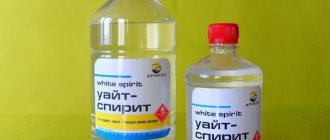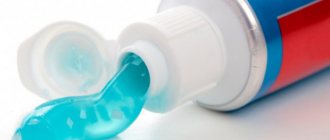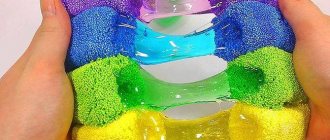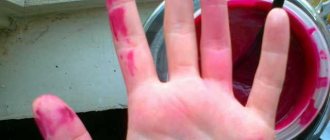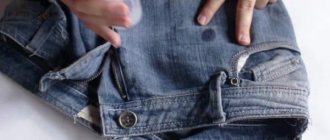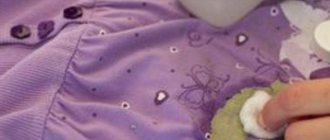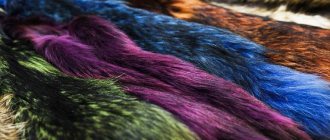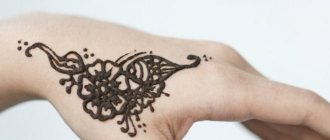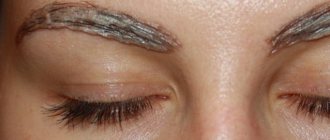Many women dye their hair at home rather than in a salon. After all, home coloring is cheaper and takes less time. But as a result, noticeable stains from the used paint often remain on the skin. To prevent this from happening in the future, you should lubricate areas of the face where paint may get on with a rich cream.
To prevent the dye from getting on your hands, you need to wear gloves. But if the problem already exists, there is no need to panic. You can erase the paint at home using available products. The chances of removing the dye without a trace increase if you start cleaning immediately after detecting contamination.
Removing paint from leather
There are many ways to remove paint from the face and skin, but not all of them are effective, and some can be harmful. Therefore, it is recommended that you familiarize yourself with the effective methods that will be presented below.
Quite effective means are all kinds of makeup removers, lotions and cosmetic milk. A special place is occupied by permanent makeup removers and wet wipes.
Hair dye can be easily removed from home remedies using soap and water. Baking soda scrub is also effective. You can also take a little vodka and remove the stain. There are many ways to remove paint from leather, so it is recommended that you familiarize yourself with them in more detail.
Recommendations from experts
When starting to remove paint from your face, it is advisable to follow these recommendations:
- Try to remove stains as soon as they appear.
- The face has sensitive skin that should not be subjected to excessive mechanical stress or contact with caustic chemicals.
- It is better to wipe off large stains with gloves so as not to stain your hands with paint.
- Professional products can cause an allergic reaction, so before the first use you should test the drug on the elbow.
- You should not, at your discretion, increase the exposure time of a remover or a homemade product, as this can lead to burns and inflammation.
- You can dye your hair only the next day after washing your hair. During this time, sebum is formed on the scalp, which serves as a natural protection. And prevents staining of the scalp.
- During the dyeing process, you should not mix natural (basma, henna) and chemical dyes.
Depending on whether permanent, unstable or natural paint was used, the approach to removing stains from the face, the intensity of exposure and the choice of recipes should be adjusted.
How to prepare for painting without getting dirty
If a stain or drip is noticed immediately, removing paint from your face will not be difficult at all.
This is what hairdressers do in salons - they try to act quickly, preventing the composition from being absorbed into the skin. Procedure:
- Soak a napkin or sponge in warm water.
- Quickly wipe the paint stain off your face.
In the case of dried stains, this method will be ineffective, and you will have to use one of the home recipes or a remover.
To prevent your skin, clothes and furniture from getting stained with hair dye, you should follow just a few rules:
- use gloves;
- wrap your neck with film;
- put on a special cape or old clothes that you don’t mind getting dirty;
- lubricate the forehead, temple and ears with fatty cream;
- when painting, use a brush;
- After applying the dye to your hair, put a shower cap on your head - this will help avoid drops of dye on the floor and furniture.
Hair dye stains eat into the skin and fabric very quickly, so you need to act immediately after discovering the stain, because the longer the pigment is exposed to the open air, the more it oxidizes and it becomes more difficult to remove. It's best to take precautions ahead of time and prepare for painting.
When starting the hair coloring procedure, you should take measures to ensure that your clothes and skin are not stained with dye. Do not neglect the rules for conducting operations with:
- protecting your hands with special gloves that come in a box with dye;
- wrapping the neck with film or waterproof cloth;
- lubricating the forehead, ears with Vaseline or baby cream;
- using a special brush for painting.
It is advisable that someone help carry out the procedure, otherwise it is difficult to dye your hair efficiently on your own. And with an assistant, painting can be done without staining your skin or clothes.
The durability and color of the paint affects the corrosiveness of the marks: dark and bright colors are more noticeable on the skin and nails, and light colors are less noticeable. As for durability, everything is clear here. Regardless of how your dye acts - it envelops the hair (unstable, tinting) or penetrates its structure (persistent) - the stains from it eat into the stratum corneum of cells in the same way.
You need to remove stains from any type of hair dye as soon as possible.
Professional cosmetics for washing
- Remover. From English "Delete". The general name for special products for removing makeup, hairspray and hair dye from the skin. Very effective products produced for the line of paints of each professional cosmetics. The most popular among them are Hair Ligth, Igora Color, Estel Professional Skin Color, Dikson Remover, UTOPIK CLEANER removers. They remove unnecessary stains without leaving a trace, are harmless to any skin, but are quite expensive. But in general, a small bottle lasts a long time, provided you paint it carefully.
- "Curl". A product used by professionals for cold perms. And they are also adapted to remove traces of inaccurate staining. An inexpensive and effective product that easily removes even old dye stains. The downside of “Lokon” is its unpleasant specific smell. To achieve the desired effect, you only need a few drops of the product applied to a cotton pad, which makes it the most economical option if you need to frequently color at home.
When choosing this or that product, you need to remember that the skin of different parts of the body differs in the degree of sensitivity. A product that can be used to remove paint from hands or nails should under no circumstances be used on the more delicate skin of the face.
We recommend: How to remove rust from clothes at home
How to remove paint from your face?
Most often, hair dye gets on the scalp in the forehead and ears. This happens due to sloppy painting.
Facial cleansers need to be chosen especially carefully. They must be delicate so as not to injure delicate skin.
Soap solution
If traces of paint were noticed immediately, you can simply wash them with soapy water. For this you will need:
- pour warm water into a container;
- add a little liquid soap there and stir the composition;
- then soak a cotton pad in this solution and try to wipe the paint off the skin.
Instead of soap, you can use shampoo and other gentle detergents.
Scrub
If bright traces of black paint cannot be removed immediately, a scrub will help. It gently exfoliates the skin, deeply cleansing it.
Algorithm of actions:
- take a special facial scrub;
- apply it to the contaminated area and massage the skin for several minutes;
- After this, wash off any remaining cosmetic product.
Compositions with large abrasive particles cannot be used for such scrubbing. In addition, you should not prepare a scrub from salt or sugar yourself, otherwise there is a risk of damaging the skin.
Lemon juice
If the paint has managed to absorb a little and can no longer be scrubbed off with regular soap, you can use lemon juice. It can whiten the skin and remove dye.
You will need to cut off a slice of lemon and wipe the problem area with it. This must be done quickly, as citric acid can cause burns.
In addition, lemon juice dries out the skin. Therefore, after cleansing, it is necessary to rinse the area thoroughly with clean water. Then you need to apply a nourishing cream to your face, which will help the skin recover.
Vodka
Another product that can quickly dissolve dye is vodka.
We recommend: How to remove lipstick stains from colored and white clothes
Mode of application:
- moisten a cotton pad with vodka;
- wipe the painted area several times;
- When the skin becomes clean, rinse it with plenty of water and lubricate it with a rich cream.
Do not use alcohol or vinegar to cleanse your face. They are aggressive and can burn the skin.
Vodka can also have a negative effect on the skin, especially dry and sensitive skin, so it must be used carefully.
Vegetable oil
If your facial skin is sensitive to external irritants, you can use a more gentle product - vegetable oil.
Procedure steps:
- apply the oil to the painted areas using a cotton pad;
- leave it for 20-30 minutes;
- after this time, wash off the oil;
- if necessary, repeat the procedure several times.
You can take olive or sunflower oil. Any cosmetic oils used in everyday skin care are also suitable.
Kefir
An unusual way to remove paint is to use kefir. Required:
- apply the fermented milk product to paint-contaminated areas;
- wait 10-15 minutes;
- then wash with warm water and soap and lubricate your face with nourishing cream.
This procedure can be repeated several times until the dye is completely removed. The effectiveness of this method lies in the lactic acid contained in kefir. It will help lighten the skin and remove paint.
Reviews
Alla S., 35 years old, Krasnodar.
“If I find an old paint stain on clothing, I apply 3% hydrogen peroxide to it and leave it for 15-20 minutes. After that, I rinse it in cold water and put it in the wash - not a trace remains of the stains.”
Natalya B., 29, Moscow.
“I never use home methods, I only trust professional remedies. With them you don’t have to worry about getting dirty or damaging your skin, they are reliable and effective, and they’re inexpensive. I buy removers from different companies in cosmetics stores, and they have never let me down: they remove paint perfectly.”
How to remove dye from skin after hair coloring
Traditional methods
Many girls prefer not to spend money on expensive removers, but to use improvised means, such as:
- soda;
- oil;
- ash;
- vinegar;
- kefir;
- toothpaste;
- lemon;
- soap;
- petrolatum;
- hydrogen peroxide.
In order not to harm the skin, you must follow the recommendations for the use of these products.
Vaseline or ash
Recommendations for the use of ash:
- For this procedure you will need wood ash or ash from a cigarette or paper.
- Coal ash should not be used.
- You need to apply the ash to a moistened cotton pad and rub the stain for 3 minutes.
- Then wash off the ash with water.
To remove paint using Vaseline you need:
- Rub it into the skin and massage in circular movements.
- This procedure should be carried out until the stain begins to wear off.
- Once the Vaseline stains, you need to wipe it off with a clean rag.
- You can rub Vaseline on the stain overnight and wipe it off in the morning.
Toothpaste or kefir
How to remove paint using kefir:
- When using this method, kefir does not need to be diluted.
- Simply apply it to the stained area and leave on for 15 minutes.
- Heavy stains should be covered with kefir using a cotton pad and washed off after half an hour.
- For hands, it is recommended to take a bath for 15 minutes.
Toothpaste is easier to use than kefir. There are several recommendations for its use:
- You need to apply a thin layer of the paste to the stain and, when it dries, rinse with water.
- The main thing to remember is that this method is not suitable for tanned and naturally dark skin.
- It is better not to use a gel-like paste, because... it is ineffective.
We recommend: How to remove grass from jeans: removing fresh and stubborn stains
Lemon or oil
Tips for using lemon:
- Lemon should not be used if a person is allergic to it.
- To remove paint stains, rub the stain with light movements. After a few minutes, rinse and treat with moisturizer.
- You can use a cotton swab soaked in lemon juice.
To erase paint with oil, you need:
- Use unrefined product.
- You need to apply it to a cotton pad and massage it into the stain.
- After an hour, wipe off the residue and rinse with warm water and soap.
Soap solution
You need to soak a cotton pad in a soap solution, wipe the stain with it, and it will disappear. Instead of soap, you can use shampoo diluted with a small amount of water.
Baking soda or vinegar
You can use baking soda to remove paint from your skin. Use the product like this:
- To make a baking soda scrub, mix it with a little water to form a soft paste.
- Wipe the stained part of your face or body with the resulting scrub and after a few minutes, rinse with running water.
- Repeat the procedure several times, but do not overdo it, otherwise you will remove a layer of skin.
Vinegar can also help remove stains. It’s easy for them to remove paint:
- First you need to heat the vinegar in a water bath.
- Then use a cotton swab to apply lotions for a few minutes.
- Wash off any remaining acid with warm soapy water.
You need to choose tartaric or malic acid, otherwise there is a high risk of getting a chemical burn.
Dye
Stains can be removed with paint itself. For this:
- take the remaining paint you used;
- apply to the contaminated area and rinse with water;
- You need to act quickly before the paint dries.
Hydrogen peroxide
A 3 percent hydrogen peroxide solution also helps remove paint stains. For this:
- moisten a cotton pad with the solution;
- apply to the stained area for a few minutes;
- rub the same area and rinse with water;
- If the stain does not disappear, it will not be as visible.
Using oil or alcohol (suitable for any paint)
Lightly scrub your hands with soap and rinse with water to remove most of the paint. You need to wash off as much as you can, you will save more oil in the future. Always start with soap and water - many water-based paints, as well as latex ones, will wash off without much effort. The sooner you can remove the paint, the better. Once it dries, stains will be a little more difficult to remove.
Apply a thin layer of mineral oil or baby oil to the painted area. Mineral oil is the best cleaner; it can be used to clean oil-based, water-based and latex-based paints.
Pour enough oil onto the area of skin to cover it, rub it in, and then wait 2-3 minutes for the oil to be absorbed. At home, any vegetable oil will do, including sunflower, olive, flax seed, etc. paint.
For convenient application of oil, use cotton pads, washcloths, etc. You just need to scrape the leather a little with something rough in texture to remove stubborn paint stains.
If the paint is still not completely washed off, you can wipe the skin with alcohol or nail polish remover. Soak a cotton pad in alcohol and use it on stains that do not respond to mineral oil.
Please note that alcohol will dry out your skin if left on for too long. Once you're done, use a moisturizer to prevent your skin from cracking or peeling.
Once you've managed to scrub off all the remaining paint, wash your hands with soap and water to get rid of the oil and alcohol smell.
Oranges and lemons are full of natural acid, which gives them the ability to dissolve substances, including dyes on the skin. Squeeze out a little juice, rub with a dry washcloth and wash off the paint stains.
If the stains still do not want to be washed off, you can use turpentine oil, but be careful: pour it onto a cloth or cotton pad, and not directly onto the skin, after which you can easily wipe off the paint. However, make sure you use it in a well-ventilated area and only use it as a last resort.
What can I do to make the paint wash off very easily?
Preventing hair dye from getting on the skin is quite difficult even for experienced hairdressers, not to mention dyeing at home. To prevent annoying spots on the forehead, cheeks, ears or neck from spoiling the mood of the new image, you need to take simple precautions. Before dyeing with any permanent or non-persistent product, it is necessary to treat the scalp along the hairline with any greasy cream or cosmetic oil. This barrier will not allow the paint to be absorbed, and after that it can be easily washed off with plain soapy water.
Dyeing your hair is sometimes not just a whim, but a necessity. Now you can do this yourself without fear of paint showing up in unexpected places. After all, there are always effective remedies at hand that will help wash away all the staining flaws and look irresistible again.

